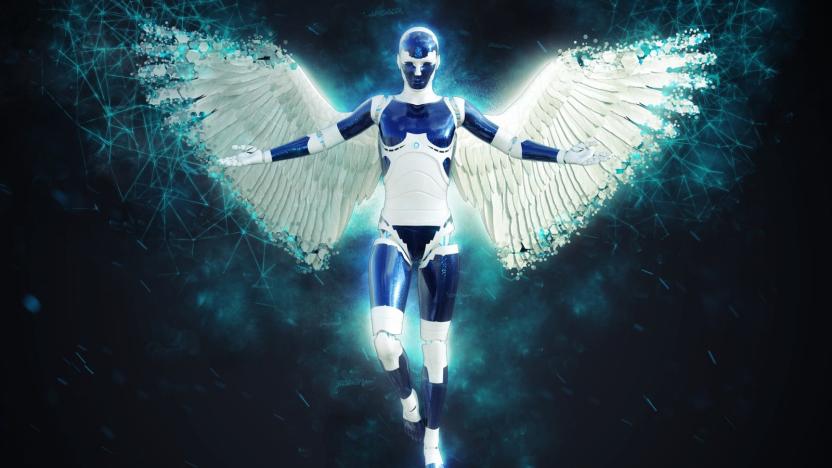machine
Latest

Researchers create a swimming robot that can 'heal' itself
Researchers at UC San Diego created a tiny robot shaped like a fish that could reassemble itself when broken apart.

An algorithm could make CPUs a cheap way to train AI
AI is the backbone of technologies such as Alexa and Siri -- digital assistants that rely on deep machine learning to do their thing. But for the makers of these products -- and others that rely on AI -- getting them "trained" is an expensive and often time-consuming process. Now, scientists from Rice University have found a way to train deep neural nets more quickly, and more affordably, through CPUs.

This machine keeps transplant livers alive for a week
With current technology, a human liver donated for transplant can only be kept alive for 24 hours, and often, if the liver is damaged or diseased, it cannot be considered for transplant. That could soon change. Liver4Life has developed a liver perfusion machine that can preserve injured human livers for one week and can even repair damage.

Scientists created living robots out of stem cells
Scientists have created a new life form that's something between a frog and a robot. Using stem cells scraped from frog embryos, researchers from the University of Vermont (UVM) and Tufts University assembled "xenobots." The millimeter-wide blobs act like living, self-healing robots. They can walk, swim and work cooperatively. Refined, they could be used inside the human body to reprogram tumors, deliver drugs or scrape plaque out of arteries.

AK-47 maker Kalashnikov has built a retro-styled EV
Russian weapons manufacturer Kalashnikov may be best known for making the AK-47 machine gun, but it's also got serious aspirations in the electric vehicle field, too. This week it unveiled a fleet of electric and hybrid cars, buggies and bikes in a move it believes will give Tesla a run for its money.

Origami-like soft robot can lift 1000 times its weight
Soft robotics allow machines to move in ways which mimic living organisms, but increased flexibility usually means reduced strength, which limits its use. Now, scientists at MIT CSAIL & Harvard have developed origami-like artificial muscles that add much-needed strength to soft robots, allowing them to lift objects as much as 1,000 times their own weight using only water or air pressure. One 2.6 gram muscle is able to lift a 3 kilogram object, which is the same as a duck lifting a car.

Uber's former self-driving lead is creating an AI religion
In a development that wouldn't be out of place in a Black Mirror episode, we could soon be worshipping an artificially intelligent god figure. And this isn't a satirical take on our existing roles as disciples of social media, or the transcendental joy we feel when an Uber Eats delivery arrives. According to state filings uncovered by Wired, in September 2015 disgraced engineer Anthony Levandowski established a non-profit religious corporation called Way of the Future. Its mission: "To develop and promote the realization of a Godhead based on artificial intelligence and through understanding and worship of the Godhead contribute to the betterment of society." In the last two months alone we've seen robots perform funeral ceremonies and AI chips mimic the human brain -- could a Deus ex Machina really be that far behind?

A robot conductor led a live orchestra performance
Just a month after humanoid robot Pepper conducted a Buddhist burial ceremony, a robo-contemporary has conducted the world-renowned Lucca Philharmonic orchestra alongside opera great Andrea Bocelli. Do robots need a heart to complete tasks of passion? As shown by YuMi, the robotic maestro designed by Swiss Firm ABB, maybe not.

Google's new reCAPTCHA automatically tells you're not a bot
Over the years, Google has utilised a number of methods to distinguish between human and bots on the web. Its take on the CAPTCHA (Completely Automated Public Turing test to tell Computers and Humans Apart) test, known as reCAPTCHA, has required you to transcribe distorted words, confirm Street View addresses or simply just tick a box. Soon, you won't need to do the hard work, because Google's making the system invisible.

Vinfusion wine robot blends a glass based on your taste
Take it from a former wine seller when I say that wine snobs are the worst, constantly trying to prove the the extent of their oenophilia. For everyone else, it's nothing but a wave of unnecessary intimidation thanks to the complexity and variety of wines and the potential risk of embarrassment. Cambridge Consultants feels that technology should be able to get us past that moment of panic that comes when you're asked to choose a wine. The company has created Vinfusion, a device that enables people to blend a glass of wine that's been customized to their specific requirements. Cheers!

HP abandons futuristic tech for its futuristic supercomputer
HP has abruptly changed course on its 'Machine,' a new type of memory-driven computer it thinks will radically alter large-scale data processing. When the company first launched it last year, the plan was to use a new kind of memory chip called the "memristor," which is as fast as DRAM but can permanently store data. The problem is that the tech, which HP expected to commercialize with Hynix in 2013, still isn't ready. Rather than giving up, though, HP has decided to take it in another direction by using both conventional RAM and phase change memory.

Competition coaxes computers into seeing our world more clearly
As surely as the seasons turn and the sun races across the sky, the Large Scale Visual Recognition Competition (or ILSVRC2014, for those in the know) came to a close this week. That might not mean much to you, but it does mean some potentially big things for those trying to teach computers to "see". You see, the competition -- which has been running annually since 2010 -- fields teams from Oxford, the National University of Singapore, the Chinese University of Hong Kong and Google who cook up awfully smart software meant to coax high-end machines into recognizing what's happening in pictures as well as we can.

HP's Machine technology rethinks the basics of computing
We've seen bits and pieces of technology that hint at the future of computing, but HP has just taken a big, big step toward bringing them all together. The company has unveiled The Machine (yes, that's the name), a processing architecture designed to cope with the flood of data from an internet of things. It uses clusters of special-purpose cores, rather than a few generalized cores; photonics link everything instead of slow, energy-hungry copper wires; memristors give it unified memory that's as fast as RAM yet stores data permanently, like a flash drive.

The Daily Grind: How old is your gaming machine?
The other day I was perusing my digital photo albums to look for pictures for Mother's Day. It was then that I spotted unboxing photos from my current desktop computer, and I realized that I had purchased this sometime between the births of my first and second kids. That put the computer's age in the four-plus range, which stunned me. Is it that old? I've been thinking about upgrading for a while, but I didn't think it was already outside of the three-year lifespan that I usually ascribe to my main machine. I guess I didn't notice because I've never had problems running MMOs on that computer (a newer graphics card certainly helped). It does concern me that there might be a day coming when my system requirements are sub-par, however. How old is your gaming machine? Do you have a top-of-the-line 2014 model or are you playing World of Warcraft on a TRS-80? Every morning, the Massively bloggers probe the minds of their readers with deep, thought-provoking questions about that most serious of topics: massively online gaming. We crave your opinions, so grab your caffeinated beverage of choice and chime in on today's Daily Grind!

Monsieur robotic bartender pours libations at home for $1,499 (hands-on)
A night out at the local watering hole can be a pain sometimes, having to elbow your way through crowds and struggle to catch the bartender's eye, all for a tasty beverage. If only we could leave all the hard work to a machine. Fortunately, Monsieur, the "robotic bartender" that we first met at TechCrunch Distrupt a few weeks ago, is back to deliver a Jetsonian experience to those who thirst for more than tech. It's certainly not the first of its kind, but the delivery method employed here is of a subtler sort, downplaying the anthropomorphic angle and hiding away the mechanism inside a streamlined casing. The home-bound version is significantly more compact (and less expensive) than the enterprise edition seen above, and it should be making its way to consumers soon. Grab a glass and join us after the break to see what's in store.

Suzumo SushiBot pumps out 300 Kwik-E-Mart rolls per hour (video)
We tend to avoid scooping up sushi whenever there's no chef in sight -- at, say, a grocery store, or a gas station -- but we've always assumed there was a human cranking out maki somewhere behind the scenes. If Suzumo's SushiBot makes it to the production line, that may no longer be the case. The compact machine doesn't exude beauty in the traditional sense, but what it lacks in elegance it easily makes up with efficiency. The contraption can plop down rice clumps for nigiri at a rate of 3,600 per hour, and -- perhaps even more impressively -- it can construct one complete sushi roll every 12 seconds, with some human assistance to place fish on the rice. We tend to like the imperfect handmade feel of the traditional Japanese delight, and we're surely not alone, so don't expect to see one these pop up in your neighborhood Asian eatery. Supermarkets, hospitals and airline caterers may be more likely to pick up a SushiBot, however. Hungry? Intrigued? Roll past the break to see how it works.

Parrot updates the AR.Drone for a second version
CES 2010 was where we first heard of the Parrot AR.Drone, a radio-controlled quadricopter that hooked up via Wi-Fi to an iPhone app. And now, two years later, that product is out and successful -- and now, obsolete. Parrot used CES 2012 a few weeks ago to introduce the AR.Drone 2.0, a brand new version of the flying drone that's set to arrive for the exact same price later on this year. Last week at CES, we got to fly the drone around through its paces. There is actually a very noticeable difference in the new version once you get behind the wheel: It's much, much harder to crash. Part of the reason for that is updates in the drone's app and firmware, but the model for 2.0 makes the craft much sturdier, and a new onboard compass (along with some other tech) means it's easier to fly as well. Things are much more stable, so the drone itself can do much more of the work of just staying in the air. You, the flyer can focus on moving it around. %Gallery-145660% In addition to general adjustments, there's also a new mode implemented called "Absolute Control." This allows the drone to fly in a certain direction, no matter where you tell it to go. It's tough to explain in just text, but the AR.Drone 2.0 "knows" where it's looking, even when you turn it around. For most people, keeping it facing the same way while tilting your iPad or iPhone to move the device is much more intuitive than having to track both the direction you're actually tilting and the direction the drone is flying. Explaining how it works is confusing, but it makes flying the drone much less so. The drone design itself appears a little smaller than before, but it's actually about the same size. Rather than changing the form factor, some of the hardware has been strengthened, with the weak points on the initial model being the main targets for the refresh. There are also new cameras on board; they will shoot up to 720p HD video, which means even on a tablet screen video from the drone is clear and crisp. Parrot has seen a lot of action with the drones on YouTube as well; in fact, while we played with the drone at CES, there was also a world championship of sorts going on, with all kinds of flyers from around the world competing after having entered by posting videos online. The new model's software (still a free download from the App Store) will now allow you to not only see video live from the drone, but also take pictures and even record full HD video directly from the device. That should make for a lot of interesting viewing online, even if you don't buy one yourself. The AR.Drone 2.0 is a significant improvement on Parrot's already popular model. At $299, the AR.Drone is a pretty expensive toy (professionally made as it might be). The more stable control scheme, however, and the addition of the 720p camera and its capture features mean the Drone 2.0 is worth another look, even if you passed the first one by. We're set to get a review model later on this year, so stay tuned for an even more in-depth look at how it all works. The device itself is supposed to be available in Q2.

Japanese vending machine doubles as WiFi hotspot -- no purchase required
It looks as if facial scans for snack-dispensing purposes isn't the only mind-blowing feature on the whiz-bang generation of vending machines. Japanese company Asahi has just unveiled an advanced dispenser that's capable of doubling as a WiFi hotspot, so good luck getting through the mobs of leechers just to buy a soda. The machine sends out the internet waves free of charge and covers about 164 feet around it; of note, there's a 30-minute limit on each session -- but it's nothing that a fresh login can't solve. Asahi is planning on rolling out 1,000 of these in the upcoming year, but if you don't call the Land of the Rising Sun your home, you won't be able to experience the smart vendors anytime soon. Now, if only this same magic would slide over to park benches, blades of grass and molecules of oxygen, we'd be content.

Eliza is a doe-eyed, graceful dancing machine, lacks maniacal quality on the floor (video)
Unlike the last batch of bots we've seen, Eliza is actually quite graceful. The cartoonish humanoid got its start as a guide, shuttling people around shopping malls and the Guangzhou Asian Games 2010 Experience Center. Now it's finally getting a chance to show off what it's got -- namely some ill dance moves. These four doe-eyed machines spin, perform complicated arm choreography in perfect synchronization, and pause to pose during this epic number. Clearly, the next step is for someone to teach them how to Dougie. Check out the videos after the break. [Thanks, Robotbling]

AutoWed vending machine concept offers marriage of convenience, nuptials at $1 a pop (video)
Dearly beloved, we are gathered here today to introduce to you perhaps the most outlandish concept we've seen all year. Looking something akin to a Moroccan Barbie accessory, and sporting a small portrait of Jesus Christ, the AutoWed Wedding machine has blasphemy written all over it. Pop in a dollar or a pound, depending on your location, and in moments you're served with a pair of plastic wedding bands and a personalized certificate, (unofficially) sealing the deal. And to think we ever raised a brow at that live crab vending machine.













